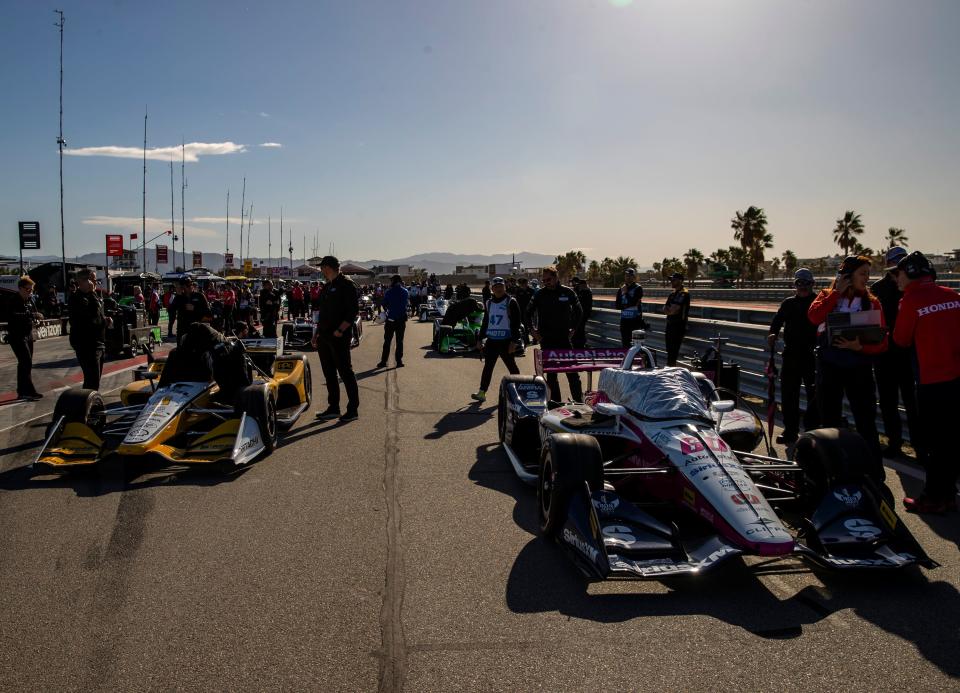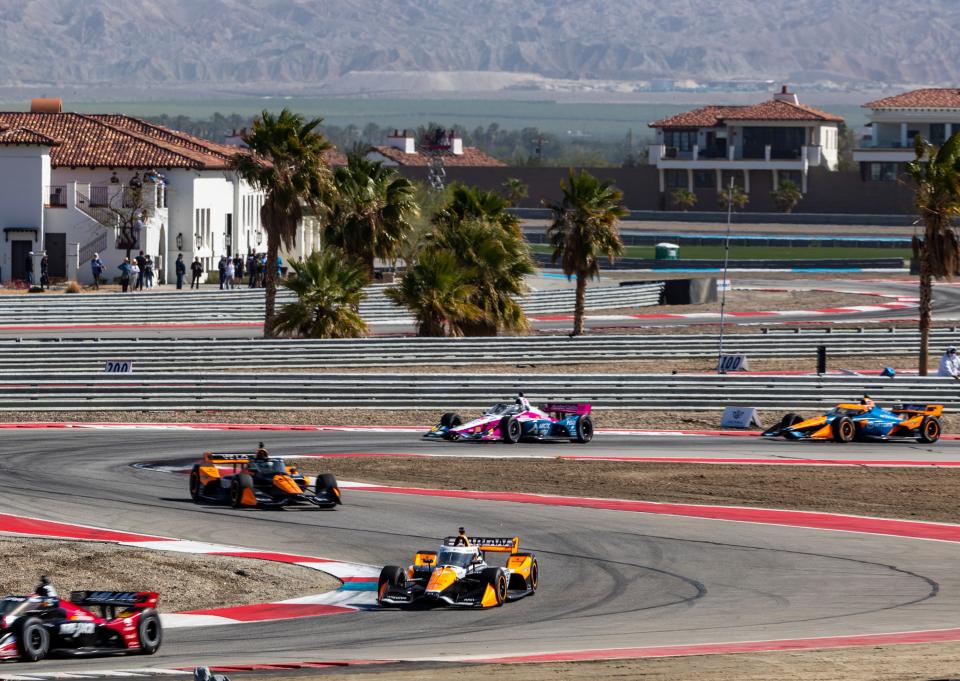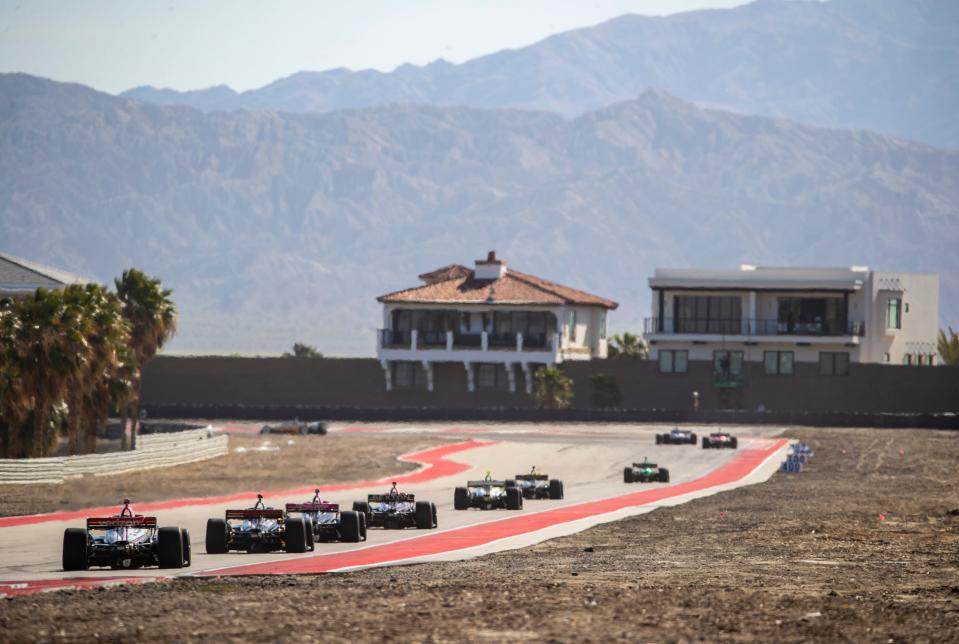Saving IndyCar's Thermal Club experiment: 9 ways to improve the $1 Million Challenge
THERMAL, Calif. – In the wake of mixed reactions to IndyCar’s $1 Million Challenge and when/where/how the series should pursue a future exhibition event, maybe only one aspect of the event could be agreed upon:
The format has to change.
On the 3.067-mile permanent road course inside The Thermal Club, IndyCar’s 10-lap heat races offered too few passing opportunities to create genuine fireworks (outside a Turn 1, Lap 1 crash), and the 20-lap finale split by a 10-minute refueling pause turned the first 10 laps into a relatively meaningless parade.
So how can this be fixed? I quizzed drivers and owners in the hour after Alex Palou celebrated his $500,000 victory for Chip Ganassi Racing and, along with some my thoughts, came up with nine ideas – from tiny tweaks to full-scale format changes – that could add some spice to the competition, if it returns.

Multiple heat races for each group
This was the talk inside the Arrow McLaren trailers among drivers and sporting director Tony Kanaan, and it’s far-and-away my favorite. Does it significantly lengthen the event, potentially making it tough to fit it into a single TV window? Perhaps, but let’s leave that logic for another time.
Option 1 is rather simple: Run a traditional 10-lap heat, then invert the field – sending 1st-place to the back – and run another. Those who advance will be determined by the top-6 average finishing positions. Option 2 adds a little spice of a traditional IndyCar race, featuring tire choices across two 10-lap heats. The caveat: You must run both compounds – one in each heat, therefore essentially deciding your tire fate before you know how Heat 1 goes. You could either run the heats separately and, like Option 1, average drivers’ finishing spots to determine those who advance, or your Heat 2 starting lineup could be off of how you finish Heat 1.
Either way, there’s far more strategy at play and keeps qualifying from having such a massive impact on those moving onto the final.
Longer heat races
If you need to keep the heat portion from getting too lengthy, you could also add a couple of laps, so tire degradation has some impact on those who advance. Lengthen the action and give drivers one more variable.
How he did it: Ganassi’s Alex Palou wins $500,000 in IndyCar’s $1 Million Challenge
Think out-of-the-box with push-to-pass
This could be used in just the main event, just the heats or both. The use of push-to-pass in qualifying was, for most, maybe one of the greatest practical realizations to come from the $1 Million Challenge. With just 40 seconds during a roughly 100-second lap and an 8-minute round (due to high tire deg), teams essentially had to nail their one chosen flying lap.
But in the races, with everyone starting with equal amounts and the difficulty to trail a leading car too closely, passing attempts could often be fended off by a leading car simply hammering the boost button. What if you could only use push-to-pass to attack a car ahead, and your button was disabled if the car behind you was using it? One would imagine we’d see more passing.
You could also give drivers increasing amounts of boost to use throughout the race, depending on where they qualified. What if the driver on pole got just 10 seconds for, say, their heat, and you went up by 5 seconds for each spot farther back on the grid, ending with 70 seconds for 13th? So, anyone could use theirs at any time, but you’d have to be far more conservative at the front. And it’s not as if those near the front, but not on pole, would have a massive advantage on the cars ahead, but it would be interesting to see how that could be used to balance out cars’ varying levels of strength.

Eliminate one driver at the end of each lap
This, too, could theoretically be used either in the heats to whittle the field down to the final six, or to determine the finishing order of the main event. Though I imagine it’s used elsewhere in various kinds of racing, I know it from racing in the Little 500 spring series events at IU, with this one called ‘Miss n Out,’ where after a group start and a couple laps of normal racing, the driver who finishes a lap last is eliminated. It makes for the racing focus to center near the back of the field and make its way up as drivers are eliminated. Those in the front could decide whether to take it easy-ish to preserve their tires and boost for the end or try and jockey for a front spot early and hope to hold it.
And if drivers start with the same amount of push-to-pass at the drop of the green, you might see those in the back burning nearly all of theirs early and those in the middle deciding how much to use so as to best help their chances of surviving.
Mixed feelings: Drivers praised IndyCar's ingenuity with $1 Million Challenge. One called for '25 boycott
Get rid of the pseudo halftime break
Of all the ideas floating out there, this seems far-and-away the most obvious. The idea, as I understood it, was to take the variance of pitstops out of the equation and put the results in the drivers’ hands once they peeled out of their pit boxes and began their warmup laps. But in order to hold a long-ish main event, IndyCar needed some way to refuel drivers’ cars so they could run longer than the maximum 18-lap stint on a full tank.
Stopping in the middle for a no-pressure fill-up allowed cars to run the entire 20 laps without a need to fuel-save, but it came with an unintended consequence: The back-half of the dozen cars, knowing there wasn’t a new set of tires waiting for them during the pause, simply made certain they didn’t get lapped. It essentially took a main event that already felt too short at 20 laps and cut it in half.
The solution? Option 1: Keep the pause and hand out new tires as well – keeping the race in drivers’ hands, but incentivizing real racing in the first 10 laps. Option 2: Delete the pause, turning the main event into a true 20-lap shootout and essentially mandate a green flag fuel stop, but outlaw teams taking tires. This would keep the importance of preserving tires but eliminate teams from doing so in way that disincentivized running competitive laps.
Give teams fueling options
Credit Pato O’Ward with quite possibly the most head-scratching idea I heard. He suggested giving teams the option to fuel up part-way and be prepared to take a live pitstop during the finale, or fuel up all the way and try and make it to the end on a fuel save. You’d have to set the lap limit just past the edge of a traditional stint that was said to be 17-18 laps – so maybe 19?
Now, teams would likely be able to number crunch enough going into this to know what the better strategy was, so what if you had a random draw and had to do perform within whatever situation you were handed? It’s tough to envision how it would best work, but perhaps there’s something there.
Make the purse truly special, starting with $1 million grand prize
As much as I don’t enjoy telling other people how to spend their money, that Sunday’s purse was advertised by IndyCar as the largest one in non-Indy 500 history, only for that to be proven wrong (see: CART’s 1996 U.S. 500 for starters), put a damper on the ‘dash for cash’ aspect of the event. That was only further emphasized that the winner of the $1 Million Challenge did not, in fact, win seven figures.
You could solely award money for those advancing to the main event, thereby eliminating $23,000 worth of payments for 15 cars, freeing up $345,000 without increasing the total purse. And with enough tools in qualifying and the heat races, as mentioned above, you could still give teams used to running mid pack a legitimate chance to make the final, making them willing to run all-out and risk crash damage.
And then, make each spot up from 12th worth more, from $25,000 all the way up to $1 million, for a purse that would fall somewhere around $4 million. Yes, of course, you’d have to find someone to fund it, but if you make the event important and enjoyable enough, perhaps there’s a way.
Hold this in the offseason
This year’s exhibition was held for the simple reason that NBC had an open network TV window with IndyCar’s loss of Texas on its regular season calendar. With a need to hold a preseason open test, this trip served that purpose and tacked on a pseudo racing product at the end.
But moving forward, when you have a full year to plan for this, IndyCar has to make this a true exhibition event. Tie it to a test weekend if you want, but don’t muddy up your regular season with a non-points event. At the same time, don’t saddle teams with crash damage – both the bill and the work – during what will prove to be an intense few weeks for testing, even if we don’t have a race for a month.

Hold some version of a full-field race
Though it wasn’t built to host 27 professional race car drivers – shown by what is thought by some to be a dangerously short pitlane and a tight track at times – why not just run a full-field race, or some version of one? Put points on the line, or don’t. Put loads of money on the line, or don’t. Get weird with push-to-pass allowances, or stages and pre-determined cautions, or something else, but why bring the entire field across the country for a race weekend and not let them all race?
Though some drivers and teams appreciate the experiment and the attempt to try something new, what they want most is to do what they love when they’re at the track, and that’s being set loose to race.
And if it’s not at the private community just outside Palm Springs, how about at an oval – whether it be a gimmick-y weekend like the one we just had, or just your normal oval race.
What if it was at a 1.5-mile oval? Maybe one IndyCar has raced at recently, and one that not long ago hosted one of its best races in years? Say, just outside the Dallas-Fort Worth?
I think they call it ‘Texas Motor Speedway.’
This article originally appeared on Indianapolis Star: How IndyCar can save the $1 Million Challenge with more money, laps

